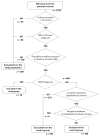Type 2 Diabetes Mellitus in Inflammatory Bowel Disease Patients: A Case-Control Study Through a Long Follow-Up Period
- PMID: 39797226
- PMCID: PMC11721770
- DOI: 10.3390/jcm14010143
Type 2 Diabetes Mellitus in Inflammatory Bowel Disease Patients: A Case-Control Study Through a Long Follow-Up Period
Abstract
Background/Objectives: The characterization of patients with inflammatory bowel disease (IBD) and type 2 diabetes mellitus (T2DM) as a new group has not been well detailed. This study aimed to evaluate the impact of T2DM on IBD progression and analyze the prevalence of steatotic liver disease and liver damage in these patients. Methods: Through a retrospective case-control study, we compared severe IBD occurrence in patients with both IBD-T2DM (cases) versus those with IBD alone (controls). Among 1047 medical records, 79 IBD-T2DM patients were selected and compared to 308 controls in a 1:4 ratio. Severe IBD was defined by variables such as surgery, target therapy, corticosteroid use, and hospitalization. Liver damage was assessed using Fib-4 (>1.3), and hepatic steatosis was evaluated by imaging. Results: There was no significant difference in severe disease rates (59.5% vs. 59.7%; p = 0.97). IBD-T2DM patients had higher rates of hepatic steatosis (62.9% vs. 27.2%; p < 0.0001) and liver damage (55.4% vs. 26.6%; p < 0.0001). IBD-T2DM patients used more corticosteroids (p < 0.0001) and fewer anti-TNF-alpha drugs (p = 0.007). The median age at diagnosis was higher in IBD-T2DM patients (48 vs. 32; p < 0.0001). In Crohn's disease, 24.3% of IBD-T2DM patients had exclusive colonic involvement compared to 5% in the IBD-only group (p = 0.003). Conclusions: T2DM was not associated with worse IBD progression, but was linked to increased liver steatosis and damage. Differences such as age of onset, colonic involvement, and liver damage suggest that IBD-T2DM patients could configure a special population worthy of further studies.
Keywords: Crohn’s disease; IBD; anti-TNF-alpha; corticosteroids; liver damage; liver steatosis; severe IBD; type 2 diabetes mellitus; ulcerative colitis.
Conflict of interest statement
The authors declare no conflicts of interest.
Figures
References
-
- García-Montero C., Fraile-Martínez O., Gómez-Lahoz A.M., Pekarek L., Castellanos A.J., Noguerales-Fraguas F., Coca S., Guijarro L.G., García-Honduvilla N., Asúnsolo A., et al. Nutritional Components in Western Diet Versus Mediterranean Diet at the Gut Microbiota-Immune System Interplay. Implications for Health and Disease. Nutrients. 2021;13:699. doi: 10.3390/nu13020699. - DOI - PMC - PubMed
-
- Hong J., Fu T., Liu W., Du Y., Bu J., Wei G., Yu M., Lin Y., Min C., Lin D. An Update on the Role and Potential Molecules in Relation to Ruminococcus Gnavus in Inflammatory Bowel Disease, Obesity and Diabetes Mellitus. Diabetes Metab. Syndr. Obes. 2024;17:1235–1248. doi: 10.2147/DMSO.S456173. - DOI - PMC - PubMed
-
- Rodrigues V.F., Elias-Oliveira J., Pereira Í.S., Pereira J.A., Barbosa S.C., Machado M.S.G., Carlos D. Akkermansia Muciniphila and Gut Immune System: A Good Friendship That Attenuates Inflammatory Bowel Disease, Obesity, and Diabetes. Front. Immunol. 2022;13:934695. doi: 10.3389/fimmu.2022.934695. - DOI - PMC - PubMed
LinkOut - more resources
Full Text Sources





